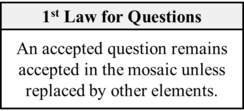The First Law for Questions (Barseghyan-Levesley-2021)
This is an answer to the question Mechanism of Scientific Inertia for Questions that states "An accepted question remains accepted in the mosaic unless replaced by other elements."
The First Law for Questions was formulated by Hakob Barseghyan and Nichole Levesley in 2021.1 It is also known as The Law of Scientific Inertia for Questions.
Contents
Scientonomic History
Acceptance Record
Suggestions To Accept
Here are all the modifications where the acceptance of this theory has been suggested:
| Modification | Community | Date Suggested | Summary | Verdict | Verdict Rationale | Date Assessed |
|---|---|---|---|---|---|---|
| Sciento-2023-0002 | Scientonomy | 28 December 2023 | Accept new formulations of the first law for theories, norms, and questions that are in tune with the formulation of the first law. Also accept new formulations of the respective rejection theorems - theory rejection, norm rejection, and question rejection. | Open |
Question Answered
The First Law for Questions (Barseghyan-Levesley-2021) is an attempt to answer the following question: What makes the questions of an agent's mosaic continue to remain in the mosaic?
See Mechanism of Scientific Inertia for Questions for more details.
Description
TODO
Reasons
No reasons are indicated for this theory.
If a reason supporting this theory is missing, please add it here.
Questions About This Theory
The following higher-order questions concerning this theory have been suggested:
If a question about this theory is missing, please add it here.
References
- ^ Barseghyan, Hakob and Levesley, Nichole. (2021) Question Dynamics. Scientonomy 4, 1-19. Retrieved from https://scientojournal.com/index.php/scientonomy/article/view/37120.
